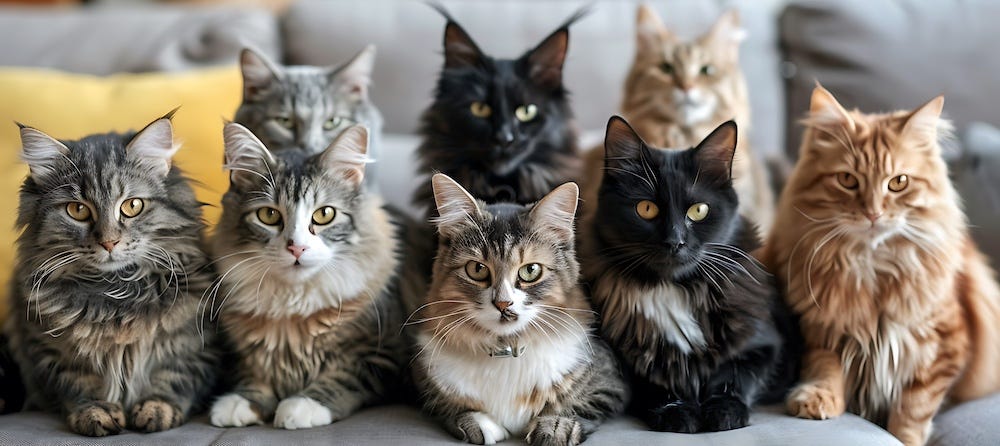Should you declaw your cat? No! We at Litter-Robot do not condone the act of declawing. This sentiment is echoed around the country. There has been a recent surge of interest in criminalizing the declawing of cats and other animals. For instance, Denver's City Council unanimously voted to pass a cat-declawing ban—effective immediately. Denver joins California cities Los Angeles, San Francisco, Santa Monica, Berkeley, Beverly Hills, Culver City, West Hollywood, and Burbank in the ban. Violators face fines, jail time, civil infraction, or all three penalties.
New York, New Jersey, Rhode Island, and West Virginia have similar bills under review, each hoping to ban declawing statewide. Already, some states (California, Rhode Island, Massachusetts, and New York) have banned landlord-mandated declawing. This makes it illegal for landlords to require their tenants to declaw and/or devocalize their pets.
New York has proposed a declawing ban for the last three years and Assemblywoman Linda Rosenthal and state Senator Joseph Griffo continue to push for its passage. In New Jersey, Assemblyman Troy Singleton has sponsored a bill that passed the lower house of its legislature in January 2017, but it has not passed the Senate. West Virginia and Rhode Island have also introduced legislation to ban declawing across their states, but have not yet been successful.
Opponents to these bans
Parties on both side of the issue agree that behavioral and alternative treatments (like nail caps) should be the front-line treatments for scratching and problem behavior. However, opponents to these bans want to preserve the legality of declawing as a measure of last resort. They argue that proper surgical technique and post-operative pain management can reduce the negative effects of declawing. They say that outlawing it may cause people to seek the procedure from unqualified, unsafe sources. Opponents warn that more cats, not fewer, may be given up to shelters when the option to declaw is removed. Most of both the approved and proposed policies make an exception to the law if declawing is deemed therapeutic for the animal. (That is, some amount of declawing treats another malady).
Read more about declawing, the surgery, and alternative treatments for clawing and scratching below.
Declawing: Not as popular as it once was
Should you declaw your cat? Again, no. Once considered a safe and routine procedure, views on declawing are changing. In fact, the evidence against elective declawing is overwhelming.
Over the past few decades, unwanted cat scratching and destructive behavior has been met with the recommendation for onychectomy, or declawing surgery. It is often packaged as a deal when you take your new kitten to get spayed or neutered. Veterinary care has normalized declawing. One study estimates a quarter (about 14 million) of domesticated cats in the US undergo onychectomy.
Declawing is not a perfect procedure
Should you declaw your cat? The answer is still no. The problem is that as common as declawing is, onychectomy is not a perfect procedure. Unlike a human nail, a cat's claw grows right out of the bone. It's a small, curved bone called the third phalanx. In addition, the most common onychectomy method uses a guillotine-like flat incision to slice through the joint between the third phalanx and the next larger bone.
Unfortunately, cutting a curved bone with a flat blade at a precise location is quite difficult. Fragments of bone may remain. Worse, the blade continues its path right through the cat's paw pads, as if cutting off the tips of your fingers.
The soft tissue damage makes for a painful, weeks-long recovery. This increases the chance for complications, like infection. Mounting evidence suggests that bone fragments and spurs left by imperfect declawing are correlated with undesirable behavior changes,specifically biting and refusal to use the litter box.
Animal advocacy groups speak out against declawing
For these reasons, veterinarians and animal advocacy groups across the world are speaking out against the procedure and advocating for alternatives. In nearly thirty countries, including the United Kingdom, Australia, and most of the European Union, declawing is illegal and considered animal cruelty and abuse. In the US, The Humane Society, ASPCA, Cat Fanciers Association, American Association of Feline Practitioners, and American Veterinary Medical Association (AVMA) all discourage elective onychectomy. They only consider it appropriate when medically necessary for either the cat or its owner.
Declawing is a major surgery
Should you declaw your cat? No, no, no. Remember, scratching is a normal part of cat behavior and serves several important purposes. Keep in mind that there are various behavioral treatments and alternatives to manage destructive scratching. Especially something as simple and harmless as nail caps! After all, declawing is a major surgery that requires amputation, not just "removing the claws."




